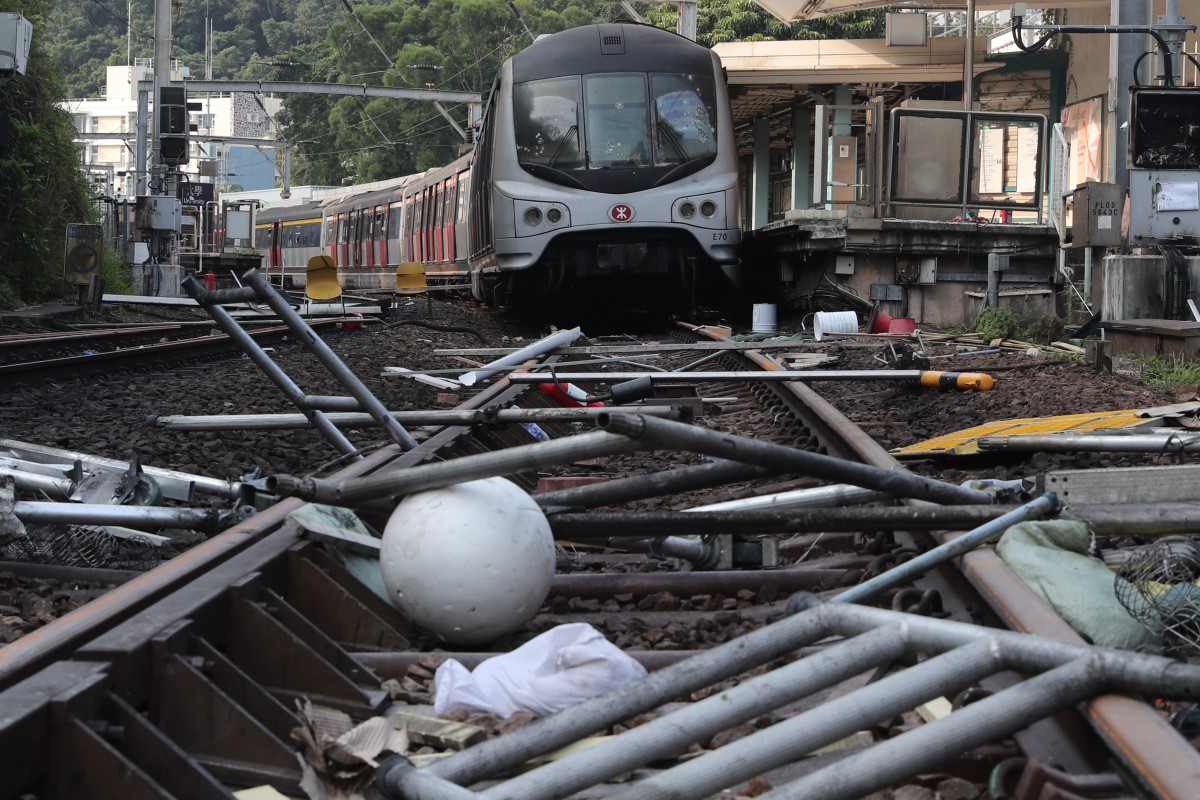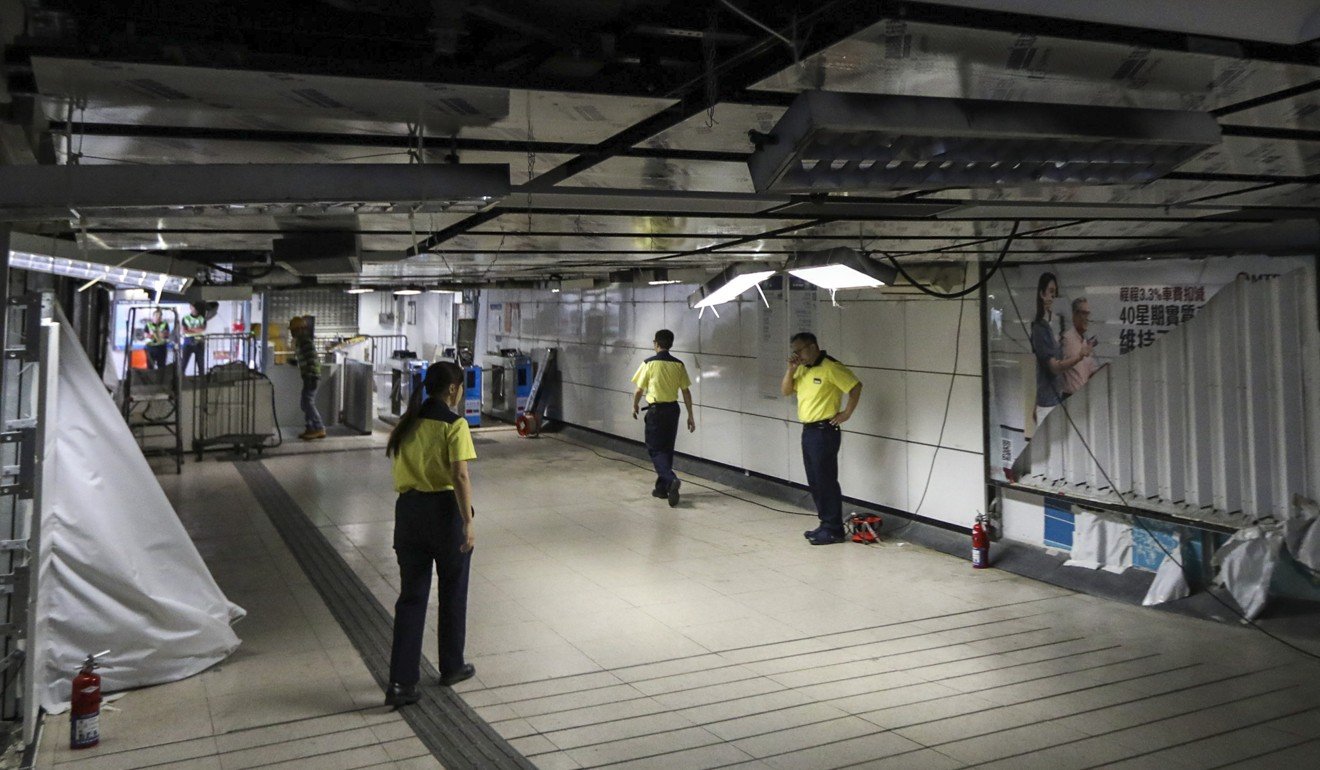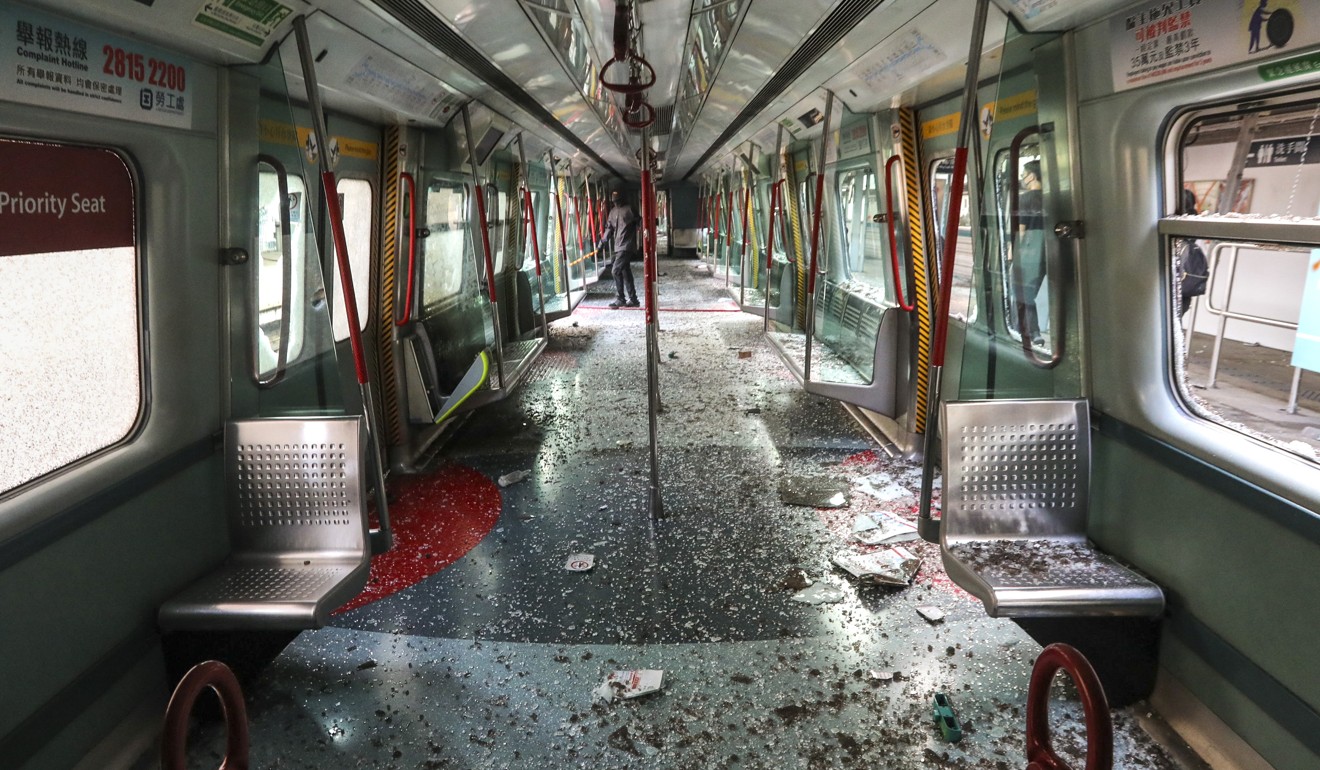Politics
Hong Kong protests: repairs of University station will be similar to rebuilding the whole facility, MTR official says

Martin Choi
Published: 9:20pm, 18 Nov, 2019

The University station still reeks of the stench of burnt plastic. Photo: Sam Tsang
The damage hard-core protesters have done to the University railway station is so severe that it will require works on a scale similar to rebuilding the whole station, a senior official of embattled train operator MTR Corporation said on Monday.
Tony Lee Kar-yun, deputy operations director of the MTR Corporation, said the station, which had been closed since last Tuesday, would remain out of bounds in the near future. On Monday, trains could pass through the station for the first time in a week.
The station, on the East Rail Line connecting Hung Hom and Lo Wu/Lok Ma Chau, still reeks of the stench of burnt plastic. Black and brown burn marks could be seen on the destroyed turnstiles and ticketing machines, as well as on the floor.
“According to the preliminary assessment of our engineering team, the station will need to undergo very deep-rooted repairs. These repairs will be similar to rebuilding the whole station,” Lee said. “Glass shards were seen everywhere [around the station] when we first arrived at the scene.”
Advertisement

As of October 29, protesters had caused extensive damage to 85 of 94 heavy rail stations and 60 of 68 Light Rail stops. Photo: Felix Wong
Share:
MTR stations and facilities have remained at a focal point of destruction by radical protesters since August when they accused the corporation of bowing to Beijing and siding with police.
As of October 29, protesters had caused extensive damage to 85 of 94 heavy rail stations and 60 of 68 Light Rail stops, setting fires, smashing equipment and ripping out fixtures.
More than 1,600 turnstiles, 960 ticketing and add-value machines, 1,100 surveillance cameras, 125 lifts and escalators, 1,060 glass panel walls and 130 sets of roller shutters were vandalised.
Since the mask ban took effect on October 5, the corporation reduced the entire network’s operating hours and even closed stations partly due to escalated and repeated damage.
Last Tuesday, the University station was vandalised when the protesters decided to paralyse the city’s key road access by blocking the Tolo Highway next to the Chinese University campus.
They wanted to force the government to meet their demands, which include universal suffrage. Transportation in the eastern and northern parts of New Territories was seriously disrupted for five days.
At the University station, the gates of one entrance had been barred shut with metal rails, bamboo poles, buckets, brooms and other debris, with the words “police and dogs cannot enter” sprawled in graffiti on the floor.
MTR station entrances to become fortresses to defend against further vandalism
Some of the glass windows inside the station were missing, while others were heavily damaged.
Communication facilities had also been destroyed, and lighting facilities could be seen dangling from the ceiling. The equipment of the control room inside the station had been removed, and the windows were missing.

The MTR Corporation has reduced the rail network’s operating hours and even closed stations partly due to escalated and repeated damage. Photo: Felix Wong
Share:
A train at University station, which had been severely damaged and burnt multiple times, was brought back to the MTR Corporation’s Ho Tung Lau depot near Fo Tan on Saturday.
Dozens of railway stations vandalised by protesters over weekend
The gangway between two compartments was severely damaged and the electric cables frayed and burnt. Some windows were missing, and lots of glass shards and debris could be seen on the ground.
The MTR Corporation sent maintenance personnel to the station on Saturday to conduct a detailed assessment of the damage and to plan how to carry out the restoration work.

The MTR Corporation urges people to stop vandalising railway facilities. Photo: Felix Wong
“The incidents over the past several days have adversely affected residents in the northern New Territories. We appeal to the parties concerned to stop vandalising railway facilities,” Lee said.
“If we see any threat to the safety of our passengers and employees, we will have to suspend the service at the affected stations or sections of railway lines, which may cause further inconvenience to passengers.”
This article appeared in the South China Morning Post print edition as: University station ‘in need of rebuilding
Hong Kong protests: repairs of University station will be similar to rebuilding the whole facility, MTR official says
- The station, which has remained closed since last Tuesday, will continue to be out of bounds in the near future
- Tony Lee, deputy operations director of the MTR Corporation, urges people to stop vandalising railway facilities

Martin Choi
Published: 9:20pm, 18 Nov, 2019

The University station still reeks of the stench of burnt plastic. Photo: Sam Tsang
The damage hard-core protesters have done to the University railway station is so severe that it will require works on a scale similar to rebuilding the whole station, a senior official of embattled train operator MTR Corporation said on Monday.
Tony Lee Kar-yun, deputy operations director of the MTR Corporation, said the station, which had been closed since last Tuesday, would remain out of bounds in the near future. On Monday, trains could pass through the station for the first time in a week.
The station, on the East Rail Line connecting Hung Hom and Lo Wu/Lok Ma Chau, still reeks of the stench of burnt plastic. Black and brown burn marks could be seen on the destroyed turnstiles and ticketing machines, as well as on the floor.
“According to the preliminary assessment of our engineering team, the station will need to undergo very deep-rooted repairs. These repairs will be similar to rebuilding the whole station,” Lee said. “Glass shards were seen everywhere [around the station] when we first arrived at the scene.”
Advertisement

As of October 29, protesters had caused extensive damage to 85 of 94 heavy rail stations and 60 of 68 Light Rail stops. Photo: Felix Wong
Share:
MTR stations and facilities have remained at a focal point of destruction by radical protesters since August when they accused the corporation of bowing to Beijing and siding with police.
As of October 29, protesters had caused extensive damage to 85 of 94 heavy rail stations and 60 of 68 Light Rail stops, setting fires, smashing equipment and ripping out fixtures.
More than 1,600 turnstiles, 960 ticketing and add-value machines, 1,100 surveillance cameras, 125 lifts and escalators, 1,060 glass panel walls and 130 sets of roller shutters were vandalised.
Since the mask ban took effect on October 5, the corporation reduced the entire network’s operating hours and even closed stations partly due to escalated and repeated damage.
Last Tuesday, the University station was vandalised when the protesters decided to paralyse the city’s key road access by blocking the Tolo Highway next to the Chinese University campus.
They wanted to force the government to meet their demands, which include universal suffrage. Transportation in the eastern and northern parts of New Territories was seriously disrupted for five days.
At the University station, the gates of one entrance had been barred shut with metal rails, bamboo poles, buckets, brooms and other debris, with the words “police and dogs cannot enter” sprawled in graffiti on the floor.
MTR station entrances to become fortresses to defend against further vandalism
Some of the glass windows inside the station were missing, while others were heavily damaged.
Communication facilities had also been destroyed, and lighting facilities could be seen dangling from the ceiling. The equipment of the control room inside the station had been removed, and the windows were missing.

The MTR Corporation has reduced the rail network’s operating hours and even closed stations partly due to escalated and repeated damage. Photo: Felix Wong
Share:
A train at University station, which had been severely damaged and burnt multiple times, was brought back to the MTR Corporation’s Ho Tung Lau depot near Fo Tan on Saturday.
Dozens of railway stations vandalised by protesters over weekend
The gangway between two compartments was severely damaged and the electric cables frayed and burnt. Some windows were missing, and lots of glass shards and debris could be seen on the ground.
The MTR Corporation sent maintenance personnel to the station on Saturday to conduct a detailed assessment of the damage and to plan how to carry out the restoration work.

The MTR Corporation urges people to stop vandalising railway facilities. Photo: Felix Wong
“The incidents over the past several days have adversely affected residents in the northern New Territories. We appeal to the parties concerned to stop vandalising railway facilities,” Lee said.
“If we see any threat to the safety of our passengers and employees, we will have to suspend the service at the affected stations or sections of railway lines, which may cause further inconvenience to passengers.”
This article appeared in the South China Morning Post print edition as: University station ‘in need of rebuilding


